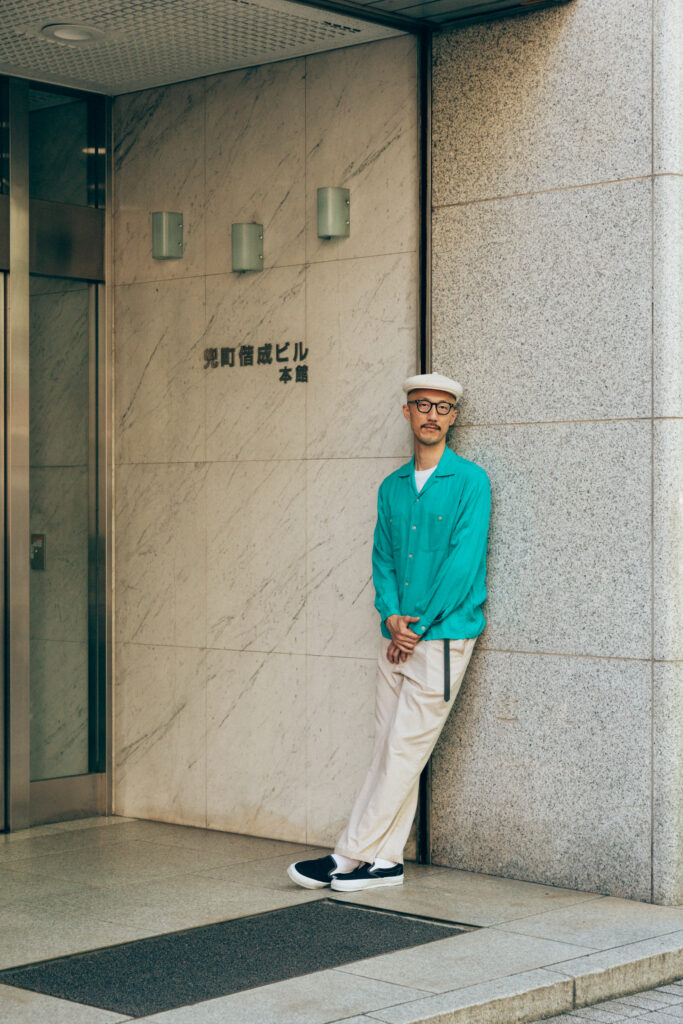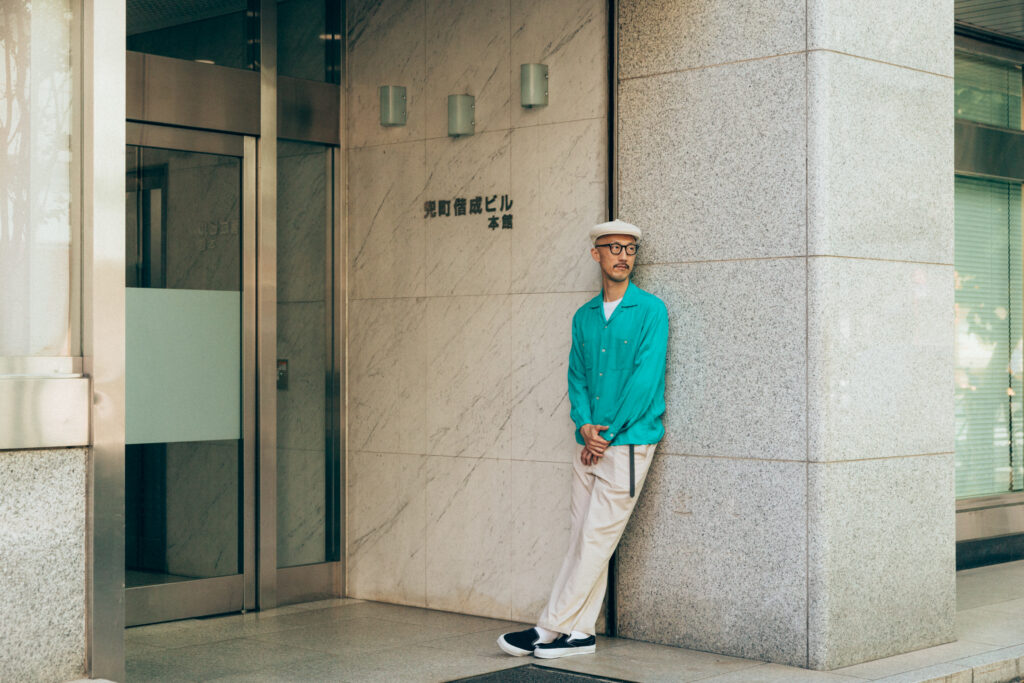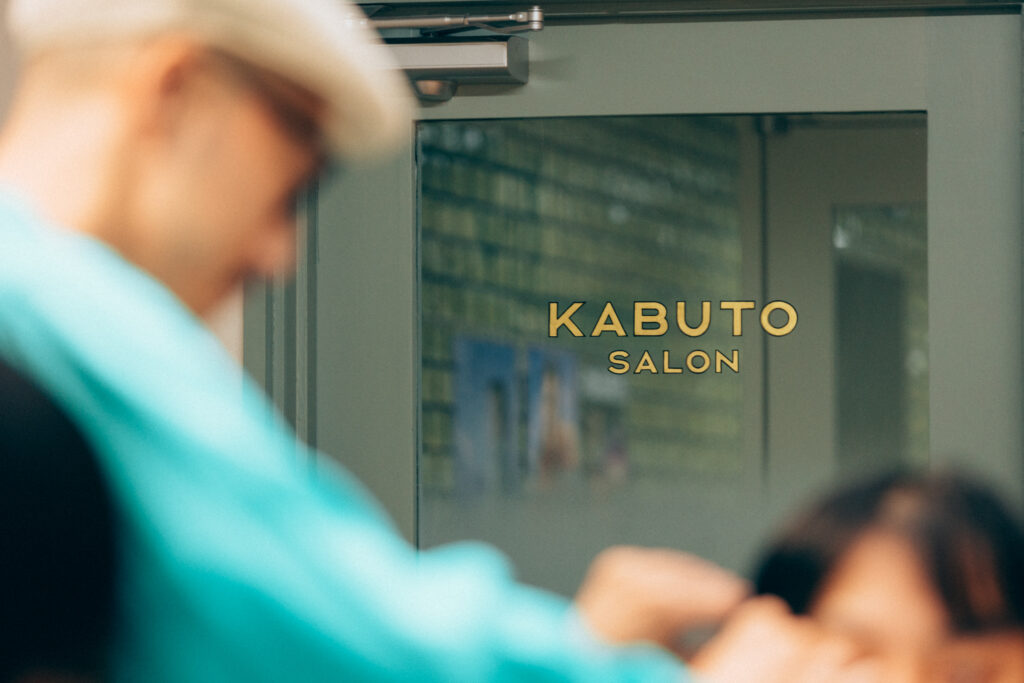


History held together by scissors
A view of the city through a mirror
To Be a Hairdresser
●When did you start working in the industry as a hairdresser?
I started working as a hairdresser when I was 22. Normally, you would enter a vocational school at 18 and start working at a shop at 20. At the time I was studying in Osaka, but there was a store in Kobe that I really wanted to work for. But I couldn’t do the job in the end. I didn’t want to work in a shop that I didn’t really like, so I went back to Kumamoto, my hometown, to give myself some distance. I ended up working part-time in a completely different type of industry. However, I was determined to become a hairdresser, so two years later I moved to Tokyo and started work at a shop in Omotesando.
● I see! And what was your student life like in Kumamoto?
I really like fashion and there are many vintage clothing stores in Kumamoto. So, I would always go to town with my three good friends that I met in high school, and we would go to vintage clothing stores and take note of American culture. The people who worked at those stores were so fashionable and would give me lots of information about fashion and culture. So I was just learning and pursuing whatever I thought was cool at the time.
●And what made you decide to become a hairdresser in the first place?
It was completely inspired by the film “Beautiful Life: The Days We Were Together”! I was in my first year of high school and had been admiring that film since I was 16 years old. I used to cut out magazines every day and make scrapbooks.
●What was the trial and interview process like for the hairdresser store you wanted to work at in Kobe?
The interview itself was normal, they asked me why I wanted to work there and what kind of hairdresser I wanted to be. There wasn’t a practical component, but I had to act as an assistant to the person in charge. I wasn’t yet in direct contact with customers, and three people were interviewing at the same time, so I had to compete with them to find a job. I went through to the final stage, always thinking ahead, like ‘The floor is dirty, maybe I should go and sweep it, but if I leave my post now they might get angry……’ Also, it felt like I hadn’t made the right fashion choice that day. I was wearing colorful vintage clothes, but everyone else was wearing understated monotone clothes. I thought, ‘What’s up with that? Something feels off!’ I don’t think I failed because of that, but unfortunately, I wasn’t hired.
●Hairdressing is a job that requires communication, right? You have to converse with an unspecified number of people who visit you and you have to get closer to them than you would with friends. So it’s not only about cutting hair and looking after yourself but also about getting a picture of the local community. Earlier, you mentioned that you worked as a hairstylist in Omotesando. Was there a gap between the image you had of Omotesando at the time and the image of the town that emerged when you actually began working there?
Yes, there was a gap. I moved from Kumamoto to Omotesando because I liked fashionable and cool things, but serving customers in the way that I was used to didn’t really work. There were days when I cried in frustration, days when I wanted to quit, but I came all the way to Tokyo, even though my father didn’t want me to, so I had to suck it up. I got to work earlier than anyone else, worked later than everyone else, and looked for models on my days off. It took me three or four years before I realized that one-way communication was simply self-indulgent.
The Importance of Remaining Neutral
●Was there a specific event that made you rethink how you communicate?
There wasn’t a specific event, but the owner of the shop did teach me to try and look at things from the customer’s perspective. Words, gestures, smiles – I don’t know specifically what triggered them – but there was a moment when I was able to shake off that feeling of wanting to give up. I started to enjoy my job after I learned to treat customers in a more neutral and flat manner, rather than showing too much of my color when I served them.
●How did you see Omotesando back during that time?
People in Omotesando were all sharp in terms of fashion and attitude. It was a place where people with a lot of originality gathered. Perhaps it was precisely because the city was such a gathering of personalities that the importance of remaining neutral became even more important. But perhaps because of that, I gradually began to see the city in a new light. I think the accumulation of these experiences became the foundation that led me to where I am today. I ended up working at the Omotesando store for 15 years, and meeting the owner there was the starting point of my career. I dove straight into Omotesando and into the store, and I’m really thankful they gave me a chance there. I was finally able to go and say hello to the owner the other day, I wanted to tell him about the opening of KABUTO SALON. He simply said “Fuku-chan, how are you?’ and it made me smile.
● That must have made the owner very happy! But what made you quit the Omotesando store?
I had always wanted to become independent. I had the opportunity to set up a shop with a friend who was also a hairdresser, and we decided that rather than doing it in Omotesando, it would be more interesting to take the culture and sensibility of Omotesando that we had experienced and put it into another town, so we set up a shop in Higashi-Ginza. There, as the shop manager, I challenged myself to find new forms of expression.
●What made you move to Kabutocho?
I had been working in Higashi-Ginza for four years, but when I thought about opening my own store, I searched for a property in Kabutocho, thinking it would be great if I could open a store in this area, especially as K5 is located there. However, it was difficult to find a property that had all the specifications for a beauty salon, including water and electricity. So I asked an old friend of mine who does the plant maintenance for K5 if he knew of any good properties in Kabutocho. Then, through various connections, I was introduced to this property, and now I run my shop from here.
●It’s almost like you were drawn to this place! But did you know about Kabutocho before moving here?
I had an image of Kabutocho as a financial district where the Tokyo Stock Exchange is located, but whenever I would visit this area, I would always get held up at Nihonbashi, so I didn’t visit Kabutocho for the first time until after K5 was built. When I saw the property that was introduced to me, it was a barbershop called “Kabuto Barber Shop,” which had been in business for 60 years, and straight away, I knew that I had found the right place! It was an instant decision.
I really felt a connection to Kabutocho, just like how I felt the connection to this property. In fact, it just so happened that Mr. Matsui of Media Surf, who is involved in Kabutocho’s urban development, came to visit us as a customer when he was operating a store in Higashi-Ginza.
●Is that so? What another great coincidence!
I felt firsthand that people really are connected to one another. It was a situation where dots became lines. Kabuto Barber Shop closed in 2021, but what surprised me was that the cash register and the red and blue sign poles from those days were all still there, as if time had stopped. The shop was run by an elderly couple, and they wanted to preserve it in some form, so they took pictures of it and displayed them in the store.
To Be The ‘Town Hairdresser’
●When I look at the photos like this, I really feel the history of the place. There’s only one seat for one customer, and I wondered how you feel about this one-on-one setting?
I’ve worked in Omotesando and Higashi-Ginza in places with many seats, but the privacy that one-on-one service provides allows for a lot of time to be dedicated to relaxation. And I feel more comfortable being able to focus on one person at a time. Perhaps because of this special setting, some customers even talk to me about their private lives! The original “Kabuto Barber Shop” had four seats, but I feel that it was a good decision to go with one-on-one service, because it allowed me to entrust my heart and soul to this place.
●The Kabuto Barber Shop has looked out over the neighborhood of Kabutocho for many years, and now Kabuto Salon will take the reigns.
That’s right! Just as “Kabuto Barber Shop” has looked at this town through a mirror for 60 years, “Kabuto Salon” must now take over and look at the Kabutocho of the future. That’s the reason why we entered this historical property, and in that sense, we have inherited “KABUTO” in the name of the salon.
● I know it’s still early days, but what kind of customers do you have at “KABUTO SALON”?
We have customers of all genders and ages, from office workers and housewives to children and the elderly. Some of our customers come from as far away as Shizuoka. Perhaps it is the nature of Kabutocho, but I feel that many customers come to the shop because they feel that it is a private space. I can sense from the conversations that I have with them that many of them like to support independent shops. I think that’s something you can’t do in Omotesando or Higashi-Ginza. There’s still the problem of rent problem, but when big capital enters the market, there is inevitably no room for individuals. But I think Kabutocho leaves a small space for independents. There are fewer and fewer towns that focus on people, but independent shops take pride in putting their customers first. I think Kabutocho has an atmosphere that encourages individuals to connect shoulder to shoulder.
●Given the stock exchange is located in Kabutocho, there’s always been a culture of dressing up for the occasion, acting almost like a good luck charm. I always found that interesting.
“Kabuto Barbershop” seems to have been just like that. Omnipollos Tokyo and Human Nature used to be eel shops, people would eat eel and then go try their luck at the stock exchange. If you did a good job, you would buy a new suit, and so there used to be many tailors in Kabutocho. I hope to create such a trend again in this area. I hope we can recreate this sense of style again.
● What kind of store do you want KABUTO SALON to evolve into?
Local greengrocers and fishmongers in the traditional shopping arcades are being squeezed out due to rising rent prices. And now large supermarkets are being built and people end up shopping there. I want to interact with people in an organic way through haircutting and through my scissors,. I want to see people’s faces, and I would like to continue to watch the town of Kabutocho from this location as long as I have the strength. Some things change, and some things don’t need to change at all. I want to be the ‘town hairdresser’ no matter how far I go, while valuing the things that don’t change and keeping in mind the mood of the moment, with the goal of enriching the daily lives of my customers as much as possible.

福田 剛広
Takahiro Fukuda
Born in Kumamoto Prefecture in 1981. Aiming to become a hairdresser since his school days, he started his career at the age of 22 in Omotesando. Later, he served as the manager of a store he founded in Higashi-Ginza. Later he was drawn to Kabutocho through personal connections, eventually taking over the historical “Kabuto Barber Shop,” which had been in business for 60 years, renaming and opening “KABUTO SALON” in 2024. He continues to see the city through scissors every day as the town’s hairdresser in a relaxing one-on-one space.
Text : Jun Kuramoto
Photo : Naoto Date
Interview : Daisuke Horie
Takahiro Fukuda
Owner of KABUTO SALON
Rieko Saito
TOUCA
Interesting people in Kabutocho
A florist opened a shop near BANK in February this year, and the flowers peeking through the show window are really beautiful. The staff there often come here for a haircut and I’m interested in them because they are independent florists.

